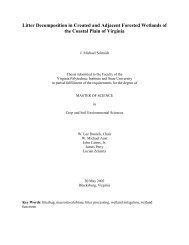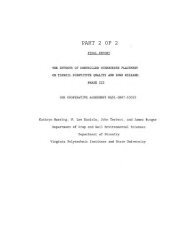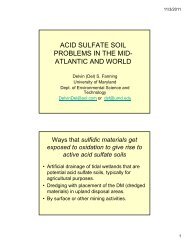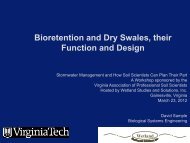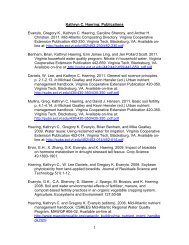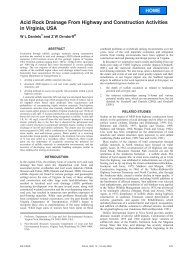Remediation of PAH-Contaminated Soils and Sediments: A ...
Remediation of PAH-Contaminated Soils and Sediments: A ...
Remediation of PAH-Contaminated Soils and Sediments: A ...
You also want an ePaper? Increase the reach of your titles
YUMPU automatically turns print PDFs into web optimized ePapers that Google loves.
� Stimulatory effects, no effect, <strong>and</strong> inhibitory effects have been reported<br />
(Kim et al., 2001; Kim <strong>and</strong> Weber, 2003). Some <strong>of</strong> the negative effects <strong>of</strong><br />
surfactants on biodegradation may be due to toxicity to microorganisms,<br />
prevention <strong>of</strong> bacterial access to contaminants through sequestration <strong>of</strong><br />
micellar solubilized organics, or preferential biodegradation <strong>of</strong> the<br />
surfactant rather than the contaminant. For instance, phenanthrene<br />
solubilized by the surfactant Tween-80 was found to be unavailable for<br />
biodegradation by Sphingomonas paucinobilis because this<br />
microorganism preferred to use the hydrophobic portion <strong>of</strong> the surfactant<br />
as a carbon source rather than destabilizing the micelles.<br />
Because <strong>of</strong> the above interactions, the determination <strong>of</strong> a critical micelle<br />
concentration for a surfactant in a complex medium such as soil can be difficult.<br />
Desorption occurs at surfactant concentrations greater than the critical micelle<br />
concentration, but at lower concentrations, admicelles (surface aggregates <strong>of</strong><br />
surfactants, also called hemimicelles) may form, sorb onto soil, <strong>and</strong> act as<br />
additional sorption sites that can enhance <strong>PAH</strong> sorption instead <strong>of</strong> reducing it<br />
(Doong et al., 1996, Santharam et al., 1997).<br />
Anionic <strong>and</strong> nonionic surfactants are more commonly used in remediation<br />
because they are less likely to sorb onto soil surfaces (Mulligan et al., 2001).<br />
Nonionic surfactants are also advantageous because they have a low critical<br />
micelle concentration, high cold water solubility, <strong>and</strong> low microbial toxicity (Kim<br />
<strong>and</strong> Weber, 2003; Zhao et al., 2005). Cuypers et al. (2002) <strong>and</strong> Conte et al.<br />
(2005) have shown that <strong>PAH</strong>s can be effectively desorbed using nonionic<br />
surfactants like dodecylbenzene sulfonate.<br />
Biosurfactants: Some synthetic surfactants can be toxic to microorganisms,<br />
which may decrease the number <strong>of</strong> degraders in the soil (S<strong>and</strong>backa et al.,<br />
2000). The addition <strong>of</strong> biosurfactants (either surfactant producing<br />
microorganisms or natural compounds that act as surfactants) is one way to get<br />
around the problem <strong>of</strong> toxicity. Biosurfactant-producing microbes have been<br />
proposed as an alternative to chemical surfactants to enhance availability <strong>of</strong><br />
hydrophobic compounds (Hunt et al., 1994; Oberbremer et al., 1990).<br />
� Pseudomonas strains can synthesize biosurfactants called rhamnolipids<br />
(Nitschke et al., 2005).<br />
� Surfactants that are produced by microorganisms tend to have lower<br />
toxicities <strong>and</strong> are effective at wider temperature, pH, <strong>and</strong> electrical<br />
conductivity ranges (Bordas et al., 2005).<br />
� Atlas (1993) found that biosurfactant-producing indigenous bacteria<br />
achieved higher hydrocarbon degradation rates than those achieved by<br />
nutrient addition alone.<br />
58



